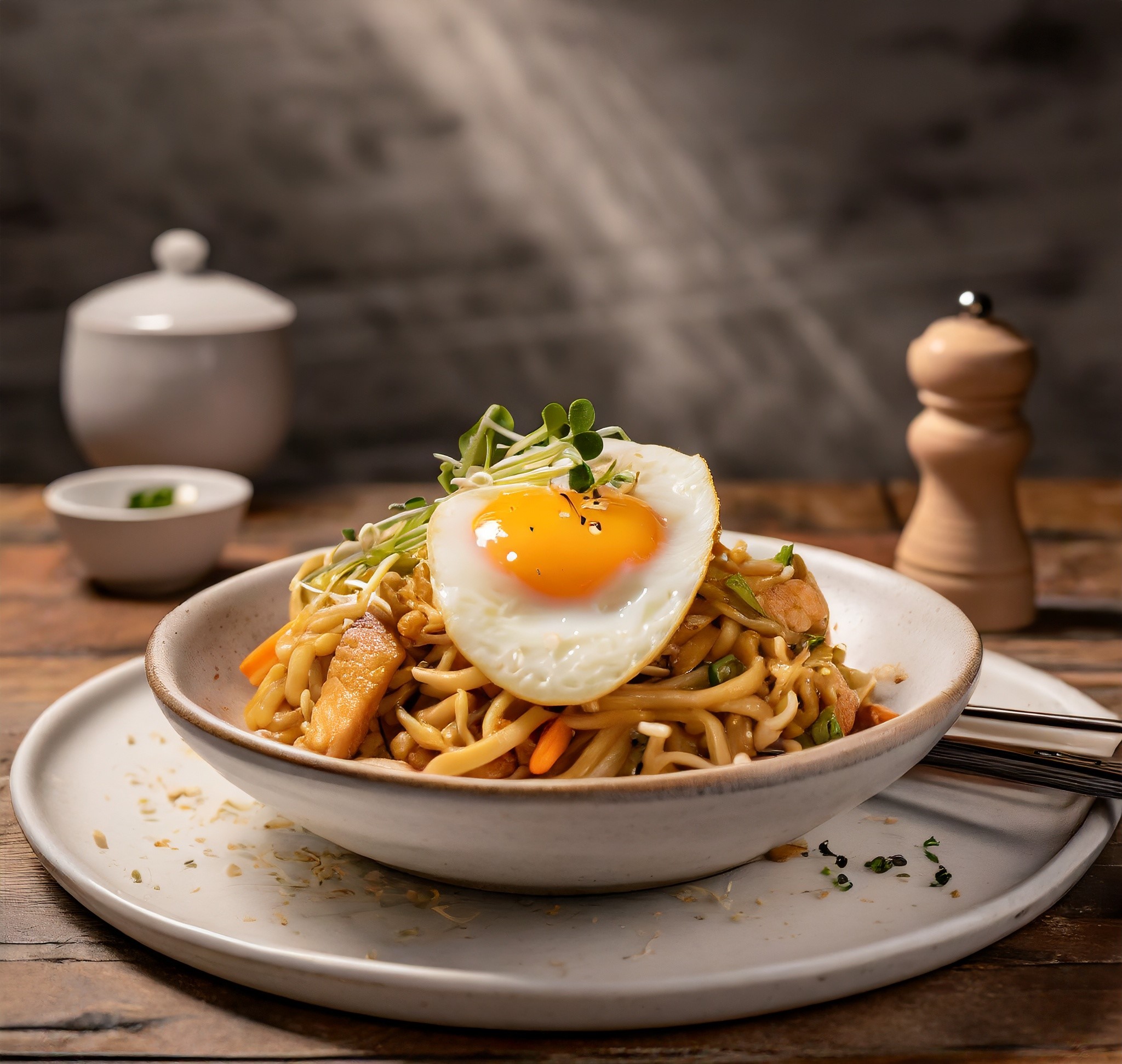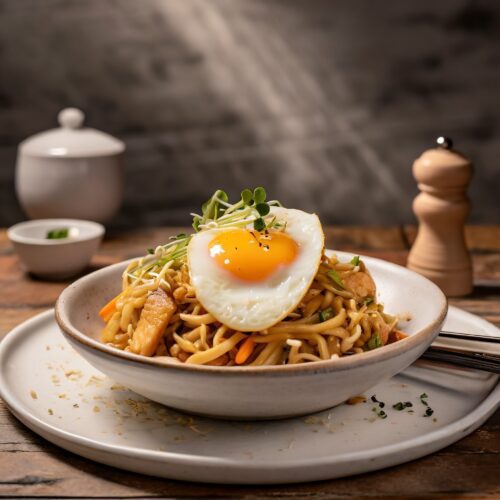Chow Mein with Egg | A Culinary Journey Through History and Flavor

Chow Mein, a cherished and remarkably versatile dish, holds a special place in the hearts and taste buds of food enthusiasts worldwide. This iconic stir-fried noodle dish, rooted in Chinese cuisine, has transcended its origins to become a beloved global culinary delight. In this article, we will embark on a journey into the world of Chow Mein, with a particular focus on its delightful pairing with eggs. We’ll explore its rich history and cultural significance, and guide you through the process, from mastering essential techniques to igniting your culinary creativity. Get ready to savor this flavorful adventure that will undoubtedly leave you craving for more!
Introduction to Chow Mein and its Versatility
What is Chow Mein?
Chow Mein, a cherished classic in Chinese cuisine, is a stir-fried noodle dish renowned for its delightful amalgamation of flavors and textures. This iconic dish typically features a blend of noodles, vegetables, and protein, all harmoniously cooked in a savory sauce. Whether served on the streets of Beijing, in a bustling New York City eatery, or in your own kitchen, Chow Mein offers a tantalizing culinary experience that appeals to diverse palates.
A Brief History of Chow Mein
Chow Mein’s origins are steeped in history, carrying with it a fascinating journey through time. Its story can be traced back to the early days of Chinese immigration to the United States. As Chinese immigrants adapted traditional stir-frying techniques to local ingredients and preferences, the delectable concoction known as Chow Mein was born. Over the years, it evolved and took on new forms, reflecting the fusion of cultures and the spirit of culinary innovation.

Chow Mein with Egg
Ingredients
- 200 grm chow mein noodles
- 2 eggs
- 1 cup thinly sliced vegetables bellpeppers, carrots, and broccoli work well
- 2 cloves of garlic, minced
- 2 tbsp vegetable oil
- 2 tbsp soy sauce
- 1 tbsp oyster sauce
- 1 tbsp sesame oil
- Salt and pepper to taste
- Chopped green onions for garnish
Instructions
- Begin by preparing all your ingredients. Chop your vegetables, mince the garlic, and have everything ready to go. This will make the cooking process smooth and efficient.
- In a large pot of boiling water, cook the chow mein noodles according to the package instructions. Usually, it takes about 2-3 minutes. Once cooked, drain and rinse them with cold water to stop the cooking process. Set them aside.
- In a large skillet or wok, heat one tablespoon of vegetable oil over medium-high heat. Add the beaten eggs and scramble them. Once they're cooked, remove them from the pan and set them aside.
- In the same skillet, add the remaining oil and stir-fry the minced garlic and sliced vegetables until they're tender but still crisp, which should take about 3-4 minutes.
- Add the cooked chow mein noodles to the pan with the vegetables. Then, pour in the soy sauce, oyster sauce, and sesame oil. Toss everything together until well combined.
- Gently fold in the scrambled eggs, ensuring they're evenly distributed throughout the dish.
- Taste the chow mein and adjust the flavor with salt and pepper if necessary. Sprinkle with chopped green onions for a burst of freshness and color.
- Plate your chow mein with egg, and serve it hot. It's a delightful, savory dish with a satisfying combination of textures and flavors.
Notes
Tips and Techniques for Perfectly Cooked Chow Mein with Egg:
– Choosing the Right Noodles: Opt for firm-textured noodles like egg or wheat noodles that can withstand stir-frying without turning mushy. – Achieving the Ideal Stir-Fry Texture: Ensure your wok or skillet is hot before adding ingredients. Stir-fry in small batches to maintain crunchiness – Balancing Flavors in the Sauce: Taste your sauce before adding it to the noodles, and adjust if needed. Add water or citrus to counter excessive saltiness, and soy sauce or vinegar to counter excessive sweetness. – Proper Heat Control and Timing: Keep the heat high to retain crispness and vibrant colors. Pay attention to cooking times to prevent overcooking or undercooking. With these tips, you’re all set to create a delectable Chow Mein with egg. Don your apron and start stir-frying, experimenting with different ingredients and flavors to craft your signature version of this classic dish. Bon appétit!Variations and Customizations to Elevate Your Chow Mein Dish:
– Vegetarian or Vegan Chow Mein Options: Looking to make your chow mein more plant-based? No problem! Swap out the chicken or beef for tofu or tempeh and load up on colorful veggies like bell peppers, mushrooms, and bean sprouts. For a vegan twist, use soy sauce or tamari instead of oyster sauce. – Seafood Chow Mein Twist: Take your Chow Mein with Egg on an aquatic adventure by adding some juicy shrimp, succulent scallops, or tender squid. Sauté them with garlic and ginger for a burst of flavor. Don’t forget to toss in some crunchy snow peas or baby corn for an extra touch of oceanic goodness. – Spicy or Sweet Chow Mein with Egg Variations: Want to kick up the heat or satisfy your sweet tooth? For a fiery twist, add chili flakes or a drizzle of Sriracha to your chow mein sauce. Craving something sweet? Try incorporating pineapple chunks or a splash of honey to balance out the savory flavors. – Exploring Regional Chow Mein with Egg Styles: Chow mein comes in many regional variations that are worth exploring. Dive into the rich flavors of Cantonese-style chow mein with its crispy noodles and savory gravy, or savor the lighter and soy-based chow mein from Shanghai. Don’t forget about the vibrant Singaporean style with its spicy kick and the hearty Hakka-style chow mein with its unique blend of meat and vegetables. The world of chow mein is full of delicious surprises!Exploring the Cultural Significance of Chow Mein
Chow Mein in Chinese Cuisine and Culture:
Chow mein is deeply rooted in Chinese cuisine and culture, originating from the Cantonese region. It has gained widespread appreciation, both within China and globally. With its blend of stir-fried noodles, protein, and vegetables, chow mein symbolizes the delicate equilibrium of flavors that exemplifies Chinese culinary artistry. This dish offers a flavorful journey into the rich traditions of Chinese cuisine.
Chow Mein’s Influence on Western Cuisine:
Chow mein’s appeal transcends Chinese borders and has found a cherished place in Western culinary landscapes. Western variations often feature crispy noodles and an expanded array of vegetables and proteins. This adaptation underscores the delectable outcomes of cultural exchange, demonstrating how a single dish can evolve and tantalize diverse palates.
Chow Mein as a Symbol of Fusion and Adaptation:
Chow mein’s global voyage is a prime example of fusion and adaptation in the world of gastronomy. It has seamlessly woven itself into various culinary fabrics, harmonizing diverse ingredients and techniques. Chow mein serves as a symbol of the way food effortlessly transcends borders, fostering connections between cultures and creating a richer, more diverse culinary world.
Conclusion and Final Thoughts on Making Delicious Chow Mein with Egg
Mastering the art of making Chow Mein with egg opens up a world of delicious possibilities in your own kitchen. With its versatility and adaptability, you can customize this dish to suit your taste preferences and dietary needs. Whether you prefer a classic vegetable and egg Chow Mein with Egg or want to experiment with different proteins and flavors, the key lies in understanding the fundamentals, using fresh ingredients, and practicing proper cooking techniques. So, roll up your sleeves, gather your ingredients, and embark on your own Chow Mein with Egg culinary adventure. Enjoy the rich flavors, delightful textures, and the satisfaction of creating a restaurant-quality dish right at home!
FAQ for Making Chow Mein with Egg
1. Can I use different types of noodles for Chow Mein?
Yes, Chow Mein can be made with various types of noodles such as egg noodles, wheat noodles, or even rice noodles. Each noodle type will impart a slightly different texture and flavor to the dish, so feel free to experiment and find your favorite!
2. Can I make Chow Mein without eggs for a vegetarian version?
Certainly! You can easily make a vegetarian version of Chow Mein by omitting the eggs and adding more vegetables or tofu as a protein substitute. Consider adding mushrooms, bell peppers, carrots, or snap peas to enhance the flavors and textures in the dish.
3. How can I prevent my Chow Mein with Egg from becoming mushy?
To avoid ending up with a mushy Chow Mein with Egg dish, make sure to stir-fry the vegetables and protein over high heat quickly. This will help retain their crunchiness and prevent them from releasing excess moisture. Additionally, be mindful not to overcook the noodles and follow the recommended cooking time on the package.
4. Can I make Chow Mein with Egg in advance and reheat it?
While it’s best to enjoy Chow Mein with Egg fresh, you can make it in advance and reheat it if needed. To maintain its texture and flavors, store the noodles and stir-fried mixture separately in airtight containers in the refrigerator. When ready to serve, reheat the stir-fried mixture in a pan over medium heat and then combine it with the noodles, tossing until heated through.
